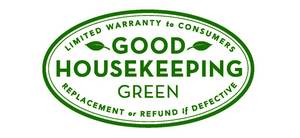NEW YORK, NY--(Marketwire - April 5, 2011) - Good Housekeeping illustrated its unwavering dedication to consumer advocacy by establishing the Green Good Housekeeping Seal, an environmental extension of the brand's well-known primary Seal. Today, the women's service magazine announces its Environmental Advisory Board consisting of leading sustainability experts from non-governmental organizations (NGOs), academia, and media. The Good Housekeeping Environmental Advisory Board will assist the magazine in many ways, such as providing insight for the Green Good Housekeeping Seal evaluations, pinpointing areas of biggest concern, and educating the magazine's more than 27 million print and online readers through interviews for editorial articles.
Inaugural members of the Good Housekeeping Environmental Advisory Board are: Laurie David, producer (An Inconvenient Truth) and award-winning, bestselling author; Wood Turner, Executive Director for Climate Counts; Suhas Apte, Vice President Global Sustainability for Kimberly-Clark; David Bennell, Executive Director, Textile Exchange; Pamela Brody-Heine, Product Stewardship Manager, Zero Waste Alliance; Jill Dumain, Patagonia; Sally Edwards, Sc.D, Research Associate at the University of Massachusetts Lowell Center for Sustainable Production; Katie Galloway, Earth Fund Manager for Aveda; Reid Lifset, M.S., M.P.P.M, Associate Director of the Industrial Environmental Management Program at Yale University; Erin Meezan, Vice President of Sustainability, Interface; Ursula Tischner, Program Coordinator Design for Sustainability at Savannah College of Art and Design; and Mary T'Kach, Energy and Sustainability Coordinator, Ramsey County, MN.
In celebration of Earth Day, at 10AM on Friday, April 22, Good Housekeeping will host a special environmentally-focused tour of the Good Housekeeping Research Institute, the magazine's state-of-the-art product testing laboratory. Visitors will have an opportunity to meet the engineers, chemists, nutritionists, and all of the Research Institute's expert staff, learn more about the Green Good Housekeeping Seal, and visit the famous Good Housekeeping Test Kitchen to hear about the increasing interest in vegetarian recipes and participate in a taste test. To sign up for the special Good Housekeeping Research Institute Earth Day tour, visit www.goodhousekeeping.com/ghritours.
Good Housekeeping created the Green Good Housekeeping Seal to set a mainstream bar for consumers who want to live a greener lifestyle. The scientists and engineers at the Good Housekeeping Research Institute worked with Brown & Wilmanns Environmental, one of the nation's leading green consultants to establish criteria for the Green Good Housekeeping Seal. Before being considered for the Green Good Housekeeping Seal, a product must pass evaluations for the primary Good Housekeeping Seal, which evaluates claims and measures efficacy to ensure it performs as promised. If the product passes, it is then reviewed using more in-depth environmental criteria, including the reduction of water use in manufacturing, energy efficiency in manufacturing and product use, ingredient and product safety, packaging reduction, and the brand's corporate social responsibility. Products that have earned the Good Housekeeping Seal and the Green Good Housekeeping Seal carry a limited warranty: If the product proves to be defective within two years of purchase, Good Housekeeping will replace the item or refund the consumer. Answers to the most frequently asked questions about the Green Good Housekeeping Seal are available at www.goodhousekeeping.com/greenGHseal.
Continuing to establish a leadership role within the environmental industry, Good Housekeeping is co-sponsoring with The Daily Green the Good and Green conference, a two-day conference on May 11 and 12 featuring a series of environmental-themed sessions, keynotes, case studies and roundtable discussions. Good and Green will be held in the Hearst Tower, the first LEED-gold certified office building in New York City. Register to attend the Good and Green conference at www.goodandgreen.biz.
About Good Housekeeping
Founded in 1885, Good Housekeeping (www.goodhousekeeping.com) magazine reaches 25 million readers each month. In addition to the print title, there is The Good Housekeeping Research Institute, the consumer product evaluation laboratory of Good Housekeeping magazine. Founded in 1900 and continuing today with the same mission, the Research Institute is dedicated to improving the lives of consumers and their families through education and product evaluation. Only products evaluated by the Good Housekeeping Research Institute can be accepted for advertising in the magazine, and thereby become eligible to display the Good Housekeeping Seal, the hallmark that provides assurance to readers that the products advertised in the magazine are backed by a two-year limited warranty against being defective, with specified exceptions. Readers can also interact with the brand on the digital front, with Good Housekeeping mobile (m.goodhousekeeping.com). In addition to its U.S. flagship, Good Housekeeping publishes 15 editions around the world. Good Housekeeping is published by Hearst Magazines, a unit of Hearst Corporation (www.hearst.com) and one of the world's largest publishers of monthly magazines, with more than 200 editions around the world, including 14 U.S. titles and 20 magazines in the United Kingdom, published through its wholly owned subsidiary, The National Magazine Company Limited. Hearst Magazines is a leading publisher of monthly magazines in the U.S. in terms of total circulation (ABC June 2010) and reaches 73 million adults (Spring, 2010 MRI).
